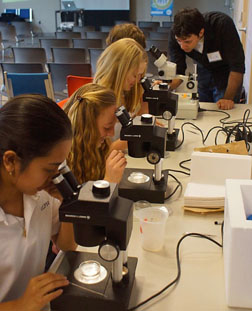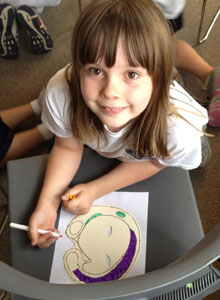Nifty Fifty event with Marnie
Halpern
By Marsha E. Lucas
|
 |
|
Marnie
Halpern at the fluorescence microscope.
(Image by Shelley Johnson) |
On April 20,
Marnie
Halpern visited some 200 students and faculty at Our
Lady of Perpetual Help (OLPH) School in Ellicott
City, Maryland on behalf of the Society for
Developmental Biology to share her research using
zebrafish to study development.
SDB nominated Halpern of the Carnegie Institution
for Science in Baltimore for the
2nd USA Science &
Engineering Festival's
Nifty Fifty (times 2)
program. With this program, 100 scientists and
engineers fanned out across the Washington, DC area
to speak about their research and careers at various
middle and high schools.
This was the second year Halpern spoke as a Nifty
Fifty scientist on behalf of SDB. In 2010 she
addressed an overflowing auditorium at Gaithersburg
High School in Maryland. This year's visit, however,
presented a particular challenge as OLPH is
comprised of elementary through middle school
students. Instead of giving a lecture about her
research, Halpern decided to spend the entire school
day at OLPH and engage each of the classes in
age-appropriate activities on zebrafish development.
Halpern enlisted the help of
BioEYES program manager
and educator, Valerie Butler, to plan targeted
activities for all the students. Due to a last
minute cancellation, Butler was able to bring the
week-long BioEYES program to OLPH for the 5th grade
students the same week as the Nifty Fifty program.
The students learned to identify male and female
fish, set up crosses, and observed embryonic and
larval development over five days. The excitement of
the 5th graders spread throughout the school, such
that by the end of the week, all the classes were
ready and primed for Halpern's Nifty Fifty visit.
|
 |
|
Students assisted by Erik Duboué observe zebrafish
mutant embryos.
(Image by Shelley Johnson) |
The Nifty Fifty program day was broken up into 30 to
45 minute sessions for each grade level to
participate in age-specific activities. Halpern
began every session with a brief introduction to
zebrafish development adapted for the grade level.
“I always show them the
movie of the developing zebrafish because everybody can relate to that. It
doesn't really matter what your age is,” she said.
“How animals develop is of great interest even to
the young children.”
Following the introductions, Halpern
conducted hands-on
activities with the help of Butler and her postdocs,
Erik Duboué and Troy Horn.
The seventh and eighth graders broke into small
groups and rotated through four different activity
stations. At station #1 they observed live embryos
and larvae from cleavage stages through 4 days under
light microscopes. At station #2 they compared wild
type embryos to
cyclops,
one-eyed pinhead,
and
no tail mutants. At station #3 the
students had to match zebrafish mutant names like
leopard,
golden,
albino, and
long fin to their corresponding adult
phenotypes. Finally, at station #4 students observed
transgenic fish expressing either green or red
fluorescent protein in the blood, blood vessels,
pancreas, and liver under a fluorescence microscope.
The grade six students also broke up into small
groups, but only rotated through stations #1 and #2
observing the wild type and mutant zebrafish
embryos. When they were not at a station, the
students made flip-books of zebrafish development.
This is an exercise that BioEYES does and is from
the
Exploratorium website, a great resource for
science activities. The students assembled cards
with a series of images of the first 48 hours of
zebrafish development on them. The cards are held
together by a binder clip and when they flip through
the book they see an embryo developing and a larvae
swim away. “It's just like a cartoon flipbook,”
Halpern said.
|
 |
|
Fifth grade students order developmental
stages. (Image by Shelley Johnson) |
Since the fifth graders had BioEYES in their
classroom all week, Halpern used the opportunity to
see how much they had learned. Their group activity
required them to put cards with illustrations (from
Kimmel et al.,1995) of various stages of
zebrafish development in the correct order. When
they were done and turned the cards over, the
letters on the back created a secret message. “They
got it pretty quickly,” Halpern said. Butler, who
worked with the fifth graders the entire week
reflected on the experience. “I had a fantastic time
at OLPH! Typically my students are enthusiastic
about their week with BioEYES, but there was
something magical with the fifth grade class at OLPH.
And I'm not just saying that.”
|
 |
|
Making a mask.
(Image by Shelley Johnson) |
The third and fourth graders spent their session
observing the developmental stages at stations #1
and #2. When they weren't at the microscopes they
decorated zebrafish embryo masks that SDB created
two years ago for the first USA Science &
Engineering Festival. The glitter glue was a hit.
Finally, the first and second graders visited
station #3 with the adult zebrafish. Observing the
fish mutants with their various pigment patterns was
a great segue into the cut-and-paste fish activity
provided by BioEYES. The students had to cut out a
zebrafish, paste fins on it, and color it to their
liking. The teachers were apprehensive about letting
the youngest students near the microscopes, but
Halpern and her postdocs allowed a few of the most
interested children observe the embryos at the
microscope.
|
 |
|
First and second grade students with
their zebrafish. (Image by Shelley Johnson) |
By the end of the day, Halpern said she learned that
keeping bright and inquisitive children
intellectually engaged is exhausting—even for her
youthful postdocs!
“Whenever I do outreach in schools it always
reinforces for me how dedicated and motivated
teachers are. The teachers just really want the kids
to expand their minds and learn about lots of
different things. I just found them very motivated
and positive. ... I strongly feel that scientists
can play a bigger role supporting what teachers do.”
Check out the SDB website for more
Nifty Fifty photos.
|